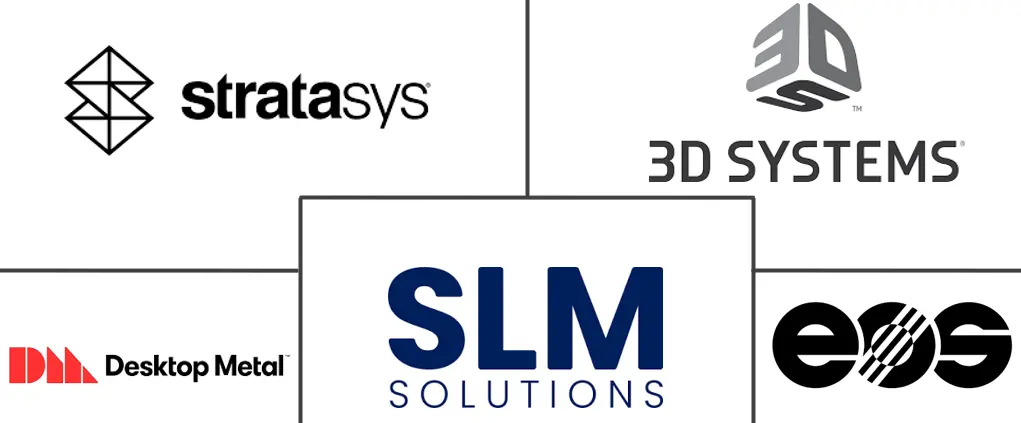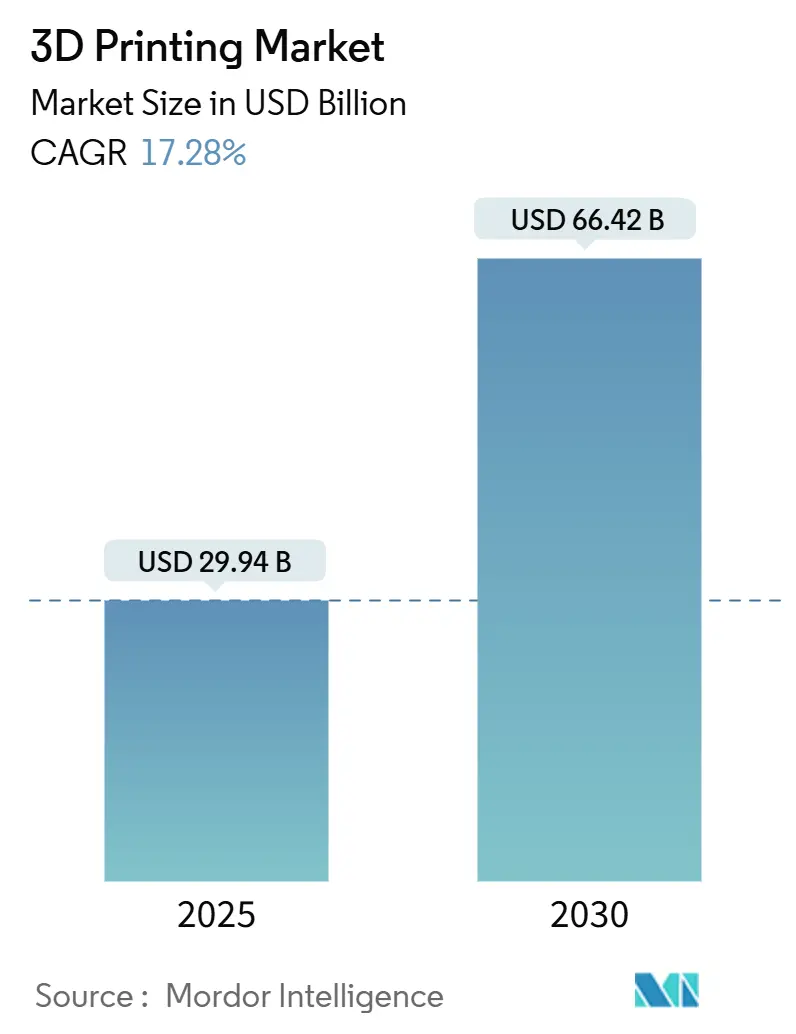
3D Printing Market Analysis by Mordor Intelligence
The 3D Printing Market size is estimated at USD 29.94 billion in 2025, and is expected to reach USD 66.42 billion by 2030, at a CAGR of 17.28% during the forecast period (2025-2030).
This growth arc is sustained by higher machine throughput, richer material portfolios, and the technology’s gradual migration from rapid prototyping to low- and mid-volume end-use production. Aerospace, healthcare, and automotive firms now validate metal and polymer parts for flight hardware, implantable devices, and structural brackets, accelerating demand for certified powders and closed-loop monitoring. At the same time, service bureaus are scaling multi-laser systems to provide cloud-based capacity that de-risks capital investments for new adopters. Strategic government funding in the United States and China compresses qualification timelines and offsets equipment costs, while ASTM-led standardization is expected to harmonize testing protocols across regions. Consolidation, such as Nano Dimension’s purchase of Desktop Metal, signals investor conviction that additive workflows will underpin next-generation supply chains.
Key Report Takeaways
- By component, hardware held 60.23% of the 3D printing market share in 2024, whereas services are forecast to expand at a 25.21% CAGR through 2030.
- By printer type, industrial systems accounted for 72.14% of the 3D printing market size in 2024; desktop systems register the fastest CAGR at 21.33% through 2030.
- By technology, material extrusion generated 45.68% revenue in 2024; vat photopolymerization is poised to grow at an 18.42% CAGR during 2025-2030.
- By material, polymers led with 65.47% revenue in 2024, while metals and alloys are projected to rise at a 26.47% CAGR over the forecast period.
- By application, prototyping represented 40.27% of the 3D printing market size in 2024; manufacturing parts advance at a 24.87% CAGR.
- By end-user industry, automotive captured 30.47% revenue in 2024, yet healthcare and dental are the fastest movers with a 25.33% CAGR to 2030.
- By region, North America commanded 41.68% revenue in 2024; Asia Pacific is expected to post a 26.47% CAGR through 2030.
Global 3D Printing Market Trends and Insights
Drivers Impact Analysis
| Driver | (~) % Impact on CAGR Forecast | Geographic Relevance | Impact Timeline |
|---|---|---|---|
| Government-funded AM hubs | +1.8% | North America | Medium term (2-4 years) |
| On-demand metal AM for aerospace spares | +1.4% | Europe | Medium term (2-4 years) |
| “Made in China 2025” equipment subsidies | +2.2% | Asia Pacific | Long term (≥ 4 years) |
| Patient-specific orthopedic implants | +1.1% | India | Long term (≥ 4 years) |
| Energy-sector shift to AM for lightweight lattice heat-exchangers in GCC | +1.3% | GCC Countries | Medium term (2-4 years) |
| Rapid tooling needs driven by EV platform proliferation globally | +1.7% | Global | Short term (≤ 2 years) |
| Source: Mordor Intelligence | |||
Government-funded Additive Manufacturing Hubs in North America
Federal and state programs continue to accelerate domestic adoption in 3D printing market. In January 2025, America Makes awarded USD 2.1 million to projects focused on in-situ metrology, sustainable powder recycling, and low-cost aluminum parameter sets. The initiative creates collaborative testbeds linking RTX Technology Research Center, Edison Welding Institute, and regional job-shops. Complementary funding under a USD 15 million ASTM Standardization Center of Excellence harmonizes data formats and test coupons, closing a persistent gap between research prototypes and qualified production. By codifying build-parameter envelopes, the ecosystem reduces redundant trials and shortens certification cycles for the 3D printing market, particularly in aerospace and medical device supply chains.
Surging Metal AM Adoption for On-demand Aerospace Spare Parts in Europe
European MRO providers increasingly rely on powder bed fusion to replace out-of-production parts without the overhead of warehousing. SpaceX’s Raptor 3 chamber, produced through multi-laser laser-powder-bed fusion, illustrates the pathway from demonstrator to flight-ready part. Euro-control agencies have clarified guidelines for non-critical metallic interiors, making small-batch economics favorable even at volumes below 30 units. Lufthansa Technik, Safran, and Rolls-Royce now stock digital inventories that trigger print orders at the point of maintenance, cutting lead times from weeks to under 48 hours. As titanium and inconel powders reach aerospace-grade repeatability, the 3D printing market in Europe benefits from reduced carbon footprints tied to localized manufacturing.
China’s ‘Made in China 2025’ Subsidies for Industrial 3DP Equipment
China’s five-year blueprint subsidizes up to 30% of capital expenditures on domestically produced metal printers. Adoption rates surged as the program met 86% of its targets, despite geopolitical scrutiny. Local OEMs such as Farsoon, BLT, and EPlus3D released quad-laser machines offering 700 mm build volumes, narrowing performance differentials with Western peers. Integrated provincial tax credits further lower the total cost of ownership, which fuels small and mid-sized enterprise participation. As a result, the 3D printing market enjoys a larger installed base, stimulating powder suppliers and application engineering firms that feed into export-oriented sectors like consumer electronics and medical devices.
Growing Demand for Patient-specific Orthopedic Implants in India
India’s Central Drugs Standard Control Organization (CDSCO) approved Monogram’s Total Knee Arthroplasty system for clinical trials, underscoring regulatory momentum for personalized implants. Surgeons employ AI-generated anatomical models derived from CT data to design cobalt-chrome or PEEK knees that match local demographic morphologies. Hospitals offset higher upfront costs through lower revision rates and shorter operating times. State insurers are piloting reimbursement codes for patient-matched joints, which may trigger volume upticks by 2027. These developments lift regional demand for sterilizable printers and powder handling systems, broadening the 3D printing market footprint across South-Asian healthcare.
Restraints Impact Analysis
| Restraint | (~) % Impact on CAGR Forecast | Geographic Relevance | Impact Timeline |
|---|---|---|---|
| Certification bottlenecks for flight-critical parts | -1.9% | Global | Long term (≥ 4 years) |
| Software-system interoperability gaps | -1.1% | Global | Medium term (2-4 years) |
| Volatility in high-performance metal powder pricing | -1.5% | Global | Short term (≤ 2 years) |
| Limited printable material palette for food-contact applications | -1.0% | Global | Medium term (2-4 years) |
| Source: Mordor Intelligence | |||
Persistent Certification Bottlenecks for Flight-critical Parts
Flight hardware like turbine nozzles or pressurization valves must comply with rigorous fracture-toughness and fatigue tests. Current rulebooks were written for subtractive machining; hence, additive parts undergo redundant coupon testing that extends schedules by up to 18 months. Only large primes can absorb the cost, limiting the 3D printing market’s reach within smaller tier-two suppliers. Though ASTM and ISO working groups are drafting method-specific standards, global alignment remains a multi-year endeavor.
Volatility in high-performance metal powder pricing
Metal powder supply chains are grappling with volatility, influenced by raw material availability, geopolitical events, and commodity price fluctuations. Aerospace, energy, and defense sectors utilize high-performance powders, such as titanium alloys and nickel superalloys, which require meticulous processing for consistent particle size and morphology. Limited production capacities exacerbate these supply constraints, as traditional methods rely on virgin metals, which are susceptible to fluctuations in global mining and refining cycles. Recent disruptions have led to a 15-25% surge in powder costs for certain applications, casting uncertainty on AM's economic viability for price-sensitive producers. Inconsistencies between batches and opaque inventory visibility complicate procurement, compelling manufacturers to hold safety stocks and endure longer lead times. Such price volatility diminishes AM's cost benefits in prototyping and low-volume production, hitting harder in emerging markets with tighter margins.
Segment Analysis
By Component: Services Unlock Flexible Access
In 2024, the hardware segment drew 60.23% of global revenue, driven by capital outlays for industrial-scale metal fusion, high-temperature polymers, and automated post-processing. Yet, from 2025 to 2030, services outpace with a 25.21% CAGR. Contract manufacturers such as Stratasys Direct Manufacturing, Materialize, and Protolabs leverage multi-site networks to distribute load, allowing customers to prototype and receive production ISO-13485 parts within ten days. The services boom lowers financial barriers, expanding the user base of the 3D printing market. By contrast, software suppliers evolve more slowly, hampered by fragmented data formats; however, as 3MF overtakes STL, opportunity emerges for cloud-native build-prep tools that embed lattice generators and cost estimation engines.
The 3D printing market benefits when OEMs bundle subscription-based machine leasing with remote monitoring. New entrants mimic copier leasing, offering print-per-hour models that fold maintenance, calibration, and powder refills into a single invoice. This hybrid approach blurs the line between hardware and services, smoothing revenue streams across macroeconomic cycles.
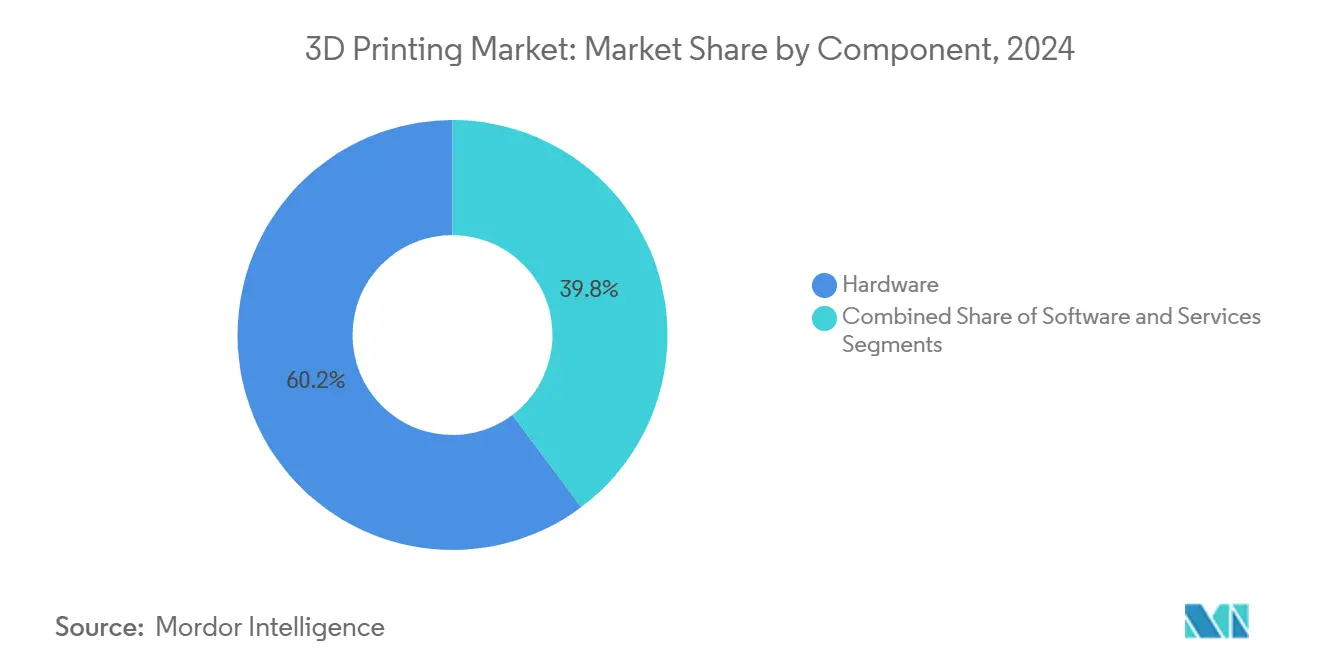
Note: Segment shares of all individual segments available upon report purchase
By Printer Type: Industrial Systems Anchor Production Shifts
Industrial platforms command 72.14% of 2024 spending as automotive, energy, and aerospace segments transition from prototype tooling to serial production. Multi-laser powder bed fusion now reaches 150 cc/hour deposition for Inconel, cracking a historical speed ceiling. Manufacturers exploit topology-optimized brackets that drop weight by 40% and consolidate assembly steps. The 3D printing market gains credibility because first-time pass rates approach those of CNC milling when build chambers incorporate powder recycling and real-time melt-pool analytics.
Desktop systems, while smaller in revenue, experience a renaissance marked by Bambu Lab’s high-speed CoreXY architectures delivering 20,000 mm/s² accelerations. Universities deploy clusters of sub-USD 1,000 units to teach design-for-additive principles, forming a talent pipeline for industrial roles. Dentists and jewelers adopt LCD resin printers that achieve 30 µm XY resolution, widening the 3D printing market beyond engineering offices.
By Technology: Material Extrusion Remains Workhorse
Material extrusion captures 45.68% of 2024 sales because FDM/FFF printers accept a wide polymer palette and maintain straightforward workflows. The latest vacuum-assisted extrusion technique slashes void content, elevating Z-axis tensile strength by 60%[2]“Vacuum-assisted extrusion cuts porosity,” Phys.org, phys.org. Vat photopolymerization grows at 18.42% CAGR as biocompatible resins enter surgical guide manufacturing. Dental labs migrate from subtractive milling, citing resin savings and surface finishes below 50 µm Ra.
Powder bed fusion continues to dominate high-value aerospace and medical implants, supported by continually falling powder costs and in-situ optical tomography. Binder jetting enters mainstream production of automotive rocker arms and hydraulic manifolds, where sintering shrinks' models have matured. Directed energy deposition (DED) addresses large-format repairs for naval propellers and wind-turbine hubs, illustrating the range of the 3D printing market across scales from micron to meter.
By Material: Metals and Alloys Accelerate
Polymers led with 65.47% revenue but face competition from metals, slated for 26.47% CAGR growth. The 3D printing market benefits as nickel super-alloy prices drop through economies of scale in atomization plants opened by Carpenter Technology and Sandvik. Dual-use commercial-defense programs expand the permissible materials roster, accelerating uptake in rocket engines, heat exchangers, and pressure vessels. Bio-based photopolymers satisfy sustainability mandates, while continuous carbon-fiber composites achieve aluminum-like strength-to-weight ratios.
Ceramics and refractories, though niche, command premium pricing for dental zirconia crowns and hypersonic vehicle nosecones. Silicon-nitride and alumina are gaining traction in semiconductor wet benches due to corrosion resistance. Composite pellets loaded with 25% chopped carbon fiber power large-format printers that create tooling for carbon-fiber autoclave molds, thereby leveraging additives to support composite lay-up workflows.
By Application: Manufacturing Parts Surpass Prototyping Growth
Prototyping retains 40.27% share, but growth moderates as design teams saturate. In contrast, manufacturing parts posting a 24.87% CAGR reveal a tipping point in the 3D printing market. Stratasys’ ToughONE resin introduces functional toughness to PolyJet workflows, allowing jigs, drone housings, and low-volume production electronics enclosures straight off the printer. Tooling applications, especially conformal-cooled injection molds, see short ROI paybacks under 60 production cycles.
Research and development applications accelerate in universities and national labs exploring architected lattices that attenuate acoustic waves. Personalized consumer goods such as custom eyewear frames leverage scan-to-print apps, illustrating the expanding consumer face of the 3D printing market. Digital inventories in sporting goods enable brands to release limited editions without forecasting risk.
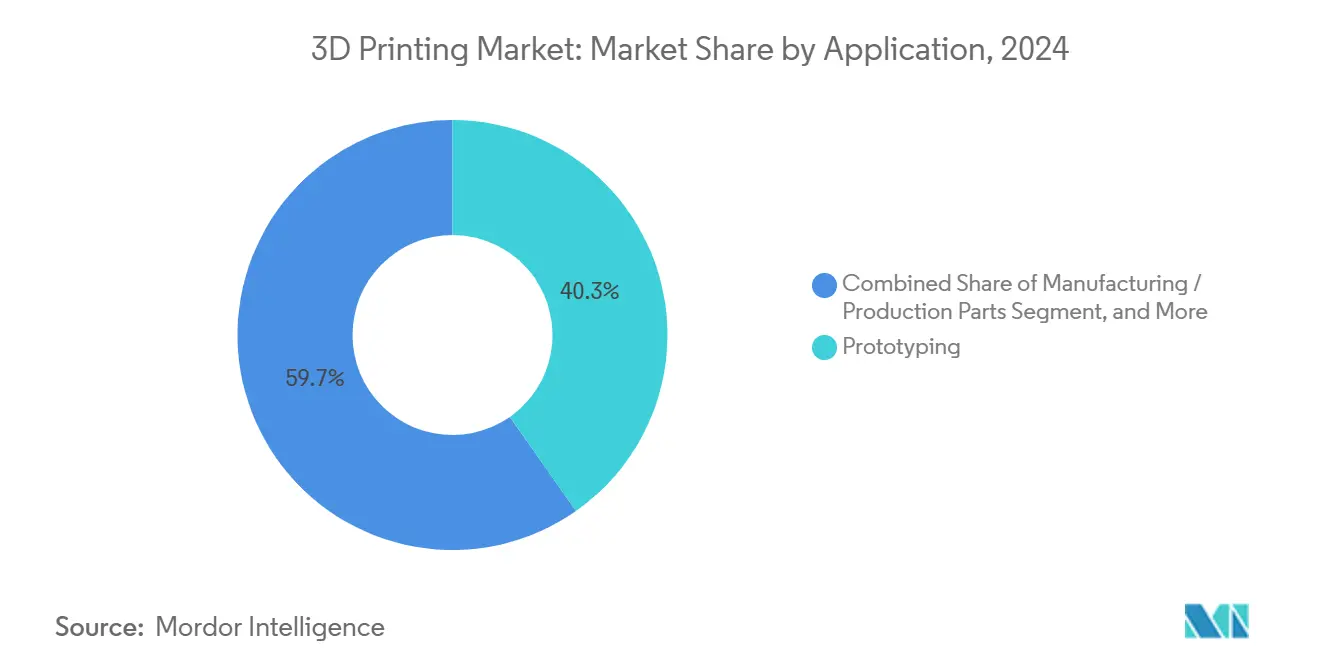
Note: Segment shares of all individual segments available upon report purchase
By End-user Industry: Healthcare Gains Momentum
Automotive captured 30.47% revenue in 2024, leveraging additive manufacturing to produce lightweight motor mounts and cockpit air vents with 50% fewer parts. Yet, healthcare and dental grow fastest at 25.33% CAGR. Point-of-care printing of patient-specific cranial plates using PEEK has reached MDR compliance in Europe. Hospitals integrate CT-to-print workflows that reduce surgery times by 30 minutes, yielding higher operating-room throughput.
Aerospace adoption expands on the strength of weight savings: a single topology-optimized bracket on the Airbus A350 trims fuel burn by 0.5 kg per flight hour. Defense agencies deploy ruggedized filament printers in forward operating bases to produce perishable spare parts, highlighting the logistical upside. The energy sector’s use of lattice heat exchangers in GCC high-temperature operations exemplifies how the 3D printing market addresses region-specific challenges. Construction firms pilot gantry systems to extrude concrete walls, although regulatory codes lag.
Geography Analysis
North America holds 41.68% of global spending, anchored by Fortune 500 adopters and a tight cluster of powder atomizers, software vendors, and contract manufacturers. America Makes funnels grant dollars toward powder recycling and real-time monitoring, closing material data sheet gaps. The U.S. Navy’s layered approach to additive manufacturing, from shipboard FDM units to depot-level DED repair, creates a structured demand pipeline. GE Aerospace’s USD 1 billion commitment to new additive facilities cements supply security for aviation alloys metal-am.com. As export controls tighten on strategic metals, onshore powder production further differentiates the North American 3D printing market.
Asia Pacific is forecast to expand at a 26.47% CAGR, influenced by China’s equipment subsidies and India’s medical adoption. Beijing’s 90% digital R&D penetration target by 2027 underpins broad-based demand for design suites and simulation software. Japan leverages additive manufacturing for micro-resolution ceramic components used in semiconductor lithography. South Korea funds joint university-industry labs to perfect metal binder jetting of copper for EV motors, supporting domestic electrification goals. In Southeast Asia, Singapore’s Advanced Remanufacturing and Technology Centre incubates hybrid additive-subtractive cells that appeal to marine and oil-rig maintenance.
Europe remains a powerhouse for both research and production. Airbus, Safran, and MTU Aero Engines co-lead standard-development consortia, ensuring geometric tolerances align across OEMs. German automakers deploy binder-jet stainless components into dashboard support brackets, citing faster cycle times than stamped alternatives at volumes under 20,000 units annually. Scandinavia seeks circular-economy credentials by integrating recycled powder streams. Eastern Europe’s contract manufacturers attract overflow orders from Western OEMs, adding to the heterogeneity of the regional 3D printing market.
Middle East oxygenates growth through energy and healthcare programs. Saudi Aramco trials corrosion-resistant lattice inserts for desalination valves exposed to high-salinity brines. UAE hospitals partner with universities to print anatomical models for complex cardiac surgeries. Africa shows pilot activity in prosthetics and spare parts, though infrastructure gaps persist. Latin America cultivates in-house tooling for consumer appliance plants; Brazil’s SENAI network teaches design-for-additive curricula, prepping a future workforce.
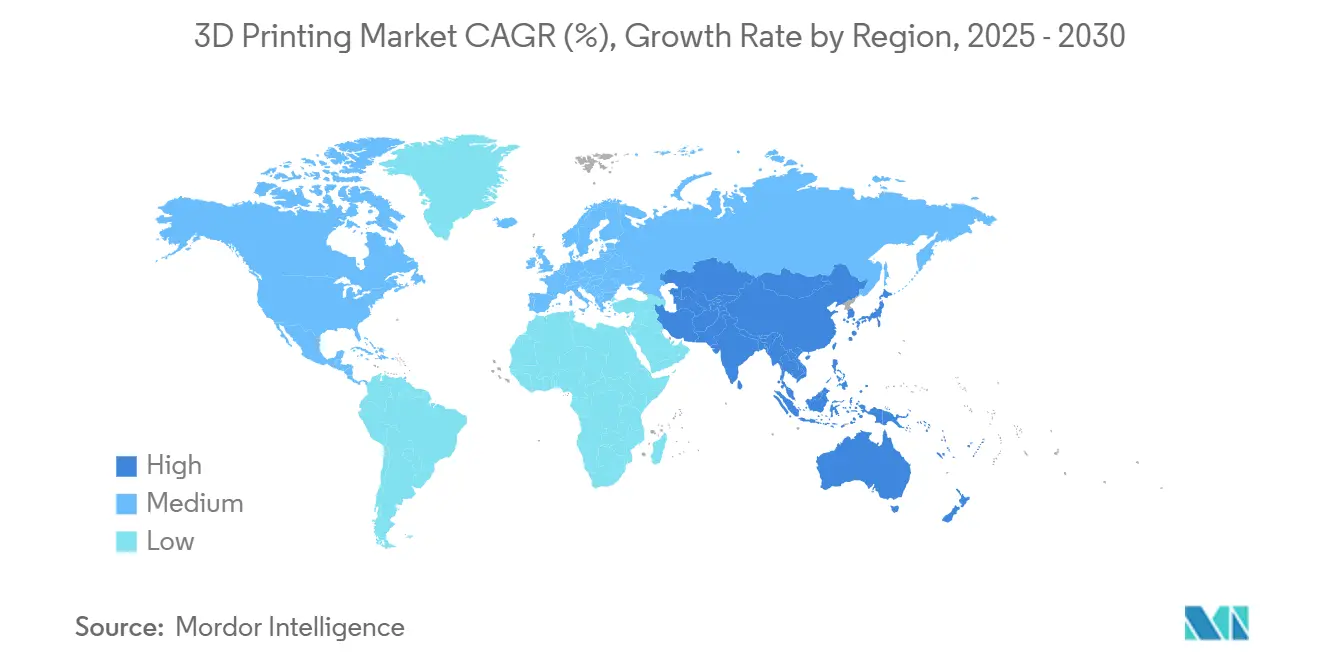
Competitive Landscape
The 3D printing market is moderately consolidated yet fluid. Nano Dimension’s USD 179.3 million takeover of Desktop Metal creates a combined playbook spanning micro-electronics to macro-scale metal parts. Stratasys reinforced liquidity by selling 14% equity to Fortissimo Capital, earmarking funds for acquisitions that fill software or bioprinting gaps. EOS integrates 1000 Kelvin’s AMAIZE AI engine to predict thermal distortions, claiming 80% engineering-time savings[1]“AI co-pilot AMAIZE integrates with EOS,” EOS GmbH, eos.info. Materialize champions open architecture, while HP’s end-to-end workflow competes on closed-loop fidelity.
Start-ups exploit niches: Boston-based Seurat applies area printing to metal applications at 10x speed; Germany’s DyeMansion leads finishing stations that give polymer parts injection-mold-like surfaces. Powder suppliers such as Höganäs and GKN push sustainable binders and recycled feedstocks, responding to ESG mandates. Interoperability remains contentious: Bambu Lab’s advocacy for 3MF pressures incumbents reliant on the decades-old STL, prompting collaborative coalitions to define richer metadata schemas. Competitive intensity keeps price points trending downward, but margins persist where vendors bundle design advisory services.
3D Printing Industry Leaders
-
Stratasys Ltd.
-
3D Systems Corporation
-
SLM Solutions Group AG
-
EOS GmbH
-
Desktop Metal Inc.
- *Disclaimer: Major Players sorted in no particular order
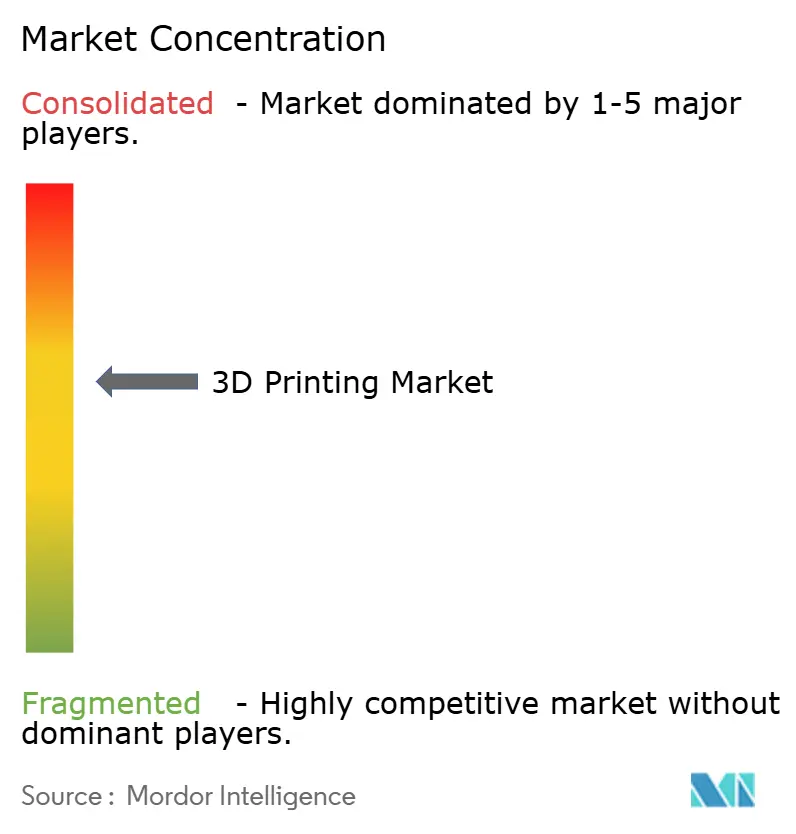
Recent Industry Developments
- January 2025: America Makes announced USD 2.1 million for projects targeting in-situ dimensional verification and sustainable aluminum parameter development.
- February 2025: ASTM International secured a USD 15 million NIST grant to establish a Standardization Center of Excellence for additive manufacturing.
- April 2025: 3D Systems produced the first MDR-compliant on-site printed PEEK facial implant at University Hospital Basel.
- April 2025: Stratasys released PolyJet ToughONE for functional prototypes and limited-run end-use parts.
Research Methodology Framework and Report Scope
Market Definitions and Key Coverage
Our study treats the global 3D printing market as all commercial revenues from hardware, software, materials, and recurring services that enable layer-wise additive manufacturing of finished or prototype parts from digital files. The universe spans industrial and desktop printers, mainstream polymer and metal feedstocks, and allied design/print workflow tools consumed across end-use industries.
Scope exclusion: purely experimental bio-printers and unassembled hobbyist kits are outside this estimate.
Segmentation Overview
- By Component
- Hardware
- Software
- Services
- By Printer Type
- Industrial 3D Printer
- Desktop 3D Printer
- By Technology
- Vat Photopolymerization (SLA, DLP)
- Powder Bed Fusion (SLS, SLM, EBM)
- Material Extrusion (FDM, FFF)
- Material Jetting
- Binder Jetting
- Directed Energy Deposition
- Sheet Lamination
- By Material
- Polymers
- Metals and Alloys
- Ceramics
- Composites
- Other Materials
- By Application
- Prototyping
- Manufacturing / Production Parts
- Tooling and Fixtures
- Research and Development
- Personalized Consumer Products
- By End-user Industry
- Automotive
- Aerospace and Defense
- Healthcare and Dental
- Consumer Electronics
- Construction and Architecture
- Energy (Oil and Gas, Power)
- Food and Culinary
- Education and Research Institutes
- Other Industries
- By Geography
- North America
- United States
- Canada
- Latin America
- Mexico
- Brazil
- Argentina
- Rest of Latin America
- Europe
- United Kingdom
- Germany
- France
- Italy
- Spain
- Rest of Europe
- Middle East and Africa
- United Arab Emirates
- Saudi Arabia
- South Africa
- Rest of Middle East and Africa
- Asia-Pacific
- China
- Japan
- South Korea
- India
- Rest of Asia-Pacific
- North America
Detailed Research Methodology and Data Validation
Primary Research
Mordor analysts interviewed printer OEM sales managers in North America, European metal-powder formulators, Asian service-bureau operators, and procurement heads from automotive and healthcare users. These discussions validated shipment run rates, material consumption ratios, and price erosion curves, especially where public data were thin. They shaped the assumptions used to adjust our global totals.
Desk Research
We collected baseline facts from freely available tier-1 sources such as the United States Census Bureau trade statistics, Eurostat PRODCOM tables, Japan's METI machinery shipment survey, and additive-manufacturing patent volumes drawn via Questel. Company 10-Ks, investor decks, and association portals like ASTM International's F42 committee minutes clarified unit pricing ranges and regulatory touchpoints. Dow Jones Factiva and national customs databases helped us map cross-border printer and powder flows that underpin regional splits. D&B Hoovers supplied audited revenue trails for leading OEMs, assisting revenue attribution by component. The sources named are illustrative; many additional publications informed data checks and context building.
Market-Sizing & Forecasting
We started with a top-down reconstruction of the global demand pool using reported printer shipments and trade data, which are then multiplied by average selling prices sourced from filings and interviews. Selective bottom-up checks, such as roll-ups of the ten largest public OEMs and sampled ASP × volume for polymers, helped fine-tune totals. Key variables inside the model include industrial versus desktop unit mix, polymer-to-metal powder consumption, regional capacity utilization in aerospace and dental labs, patent intensity as a proxy for technology diffusion, and annual ASP deflation. Multivariate regression on these drivers yields the five-year outlook, while scenario analysis captures swings in capex cycles and material input costs.
Data Validation & Update Cycle
Outputs pass three layers of variance screening, peer review, and management sign-off. We re-contact respondents when anomalies exceed preset thresholds and refresh the model every twelve months, with interim updates for material events so clients always receive our most current view.
Why Mordor's 3D Printing Baseline Stands Reliable
Published figures often differ because firms choose dissimilar component mixes, growth levers, and refresh cadences.
Key gap drivers include diverging scope (some tally printers only), reliance on unverified shipment multipliers, or aggressive straight-line CAGR extensions without segment-level ASP controls. Our disciplined inclusion of services and materials, annual model refresh, and dual-path validation make the baseline more dependable for planners.
Benchmark comparison
| Market Size | Anonymized source | Primary gap driver |
|---|---|---|
| USD 29.94 B (2025) | Mordor Intelligence | - |
| USD 16.16 B (2025) | Global Consultancy A | Excludes software and services; limited primary checks; biennial updates |
| USD 24.80 B (2024) | Trade Journal B | Earlier base year; lumps materials with hardware and extends CAGR without ASP validation |
These comparisons show that when scope, variables, and refresh rigor are aligned, Mordor's balanced approach delivers a transparent, repeatable baseline that decision-makers can trust.
Key Questions Answered in the Report
What is the current 3D Printing market size?
The global 3D Printing market size stands at USD 25.32 billion in 2024.
What is the current value of the 3D printing market and how fast is it growing?
The 3D printing market is valued at USD 25.32 billion in 2024 and is projected to reach USD 66.42 billion by 2030, registering a 17.28% CAGR between 2025 and 2030.
Which segment of the 3D printing market is expanding the fastest?
The services segment, which lets firms outsource production rather than buy machines, is forecast to grow at a 25.21% CAGR through 2030.
Why is Asia Pacific the fastest-growing region?
Aggressive government programs like China’s “Made in China 2025” subsidize printer purchases and push digital R&D adoption, driving a 26.47% regional CAGR.
How are certification challenges affecting aerospace adoption?
Flight-critical parts still face testing regimes that can add 12-18 months to development, restraining smaller suppliers despite proven performance benefits.
Which materials are gaining traction beyond polymers?
Metals and alloys lead with a projected 26.47% CAGR due to broader aerospace, medical, and automotive use cases, supported by falling powder costs and multi-laser printers.
What strategic moves are reshaping the competitive landscape?
Nano Dimension’s USD 179.3 million acquisition of Desktop Metal and Stratasys’ USD 120 million equity raise highlight consolidation aimed at building end-to-end platforms.
Page last updated on:
